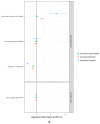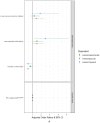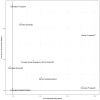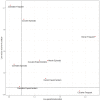Socioeconomic Status, Parental Education, School Connectedness and Individual Socio-Cultural Resources in Vulnerability for Drug Use among Students
- PMID: 32085546
- PMCID: PMC7068584
- DOI: 10.3390/ijerph17041306
Socioeconomic Status, Parental Education, School Connectedness and Individual Socio-Cultural Resources in Vulnerability for Drug Use among Students
Abstract
Background and aims: Families who live in a disadvantaged socioeconomic situation frequently face substandard housing, unsafe neighborhoods, inadequate schools and more stress in their daily lives than more affluent families, with a host of psychological and developmental consequences that can hinder their children's development in many ways. However, the measurement of socioeconomic status among youth and its link with different forms of illicit substance use is challenging and still unclear. This paper extends existing research on the relationship between socioeconomic status and illicit drug use among adolescents by focusing on three different patterns of use (experimental, episodic and frequent) and making use of two indicators to improve the measurement of individual socioeconomic characteristics in a big sample of European students.
Methods: Data were drawn from the European school Survey Project on Alcohol and other Drugs (ESPAD), which, since 1995, collects comparable data among 15-to-16-year-old students to monitor trends in drug use and other risk behaviors across Europe. The sample comes from 28 countries that participated in the 2015 data collection. The consumption of cannabis, cocaine and heroin are considered, and the related patterns are identified based on the frequency of use. Family characteristics at student level are defined through two dimensions: parental educational level and perceived socioeconomic status. Multivariate multilevel mixed-effects logistic regression was performed in order to measure the association between individual characteristics and vulnerability for drug use.
Results: Some patterns of use, episodic and frequent in particular, were found strongly associated with a lower socioeconomic status and lower parental education.
Conclusions: Our results suggest that drug policies should be combined with actions aimed at removing barriers to social inclusion that are attributable to the socioeconomic background of adolescents.
Keywords: cannabis; cocaine; drug use; heroine; parental education; socioeconomic inequalities.
Conflict of interest statement
The authors declare no conflicts of interest.
Figures








Similar articles
-
Illicit drugs use in Georgian students; pilot study rigorously following criteria of European School Project on Alcohol and Other Drug.Georgian Med News. 2010 Mar;(180):39-46. Georgian Med News. 2010. PMID: 20413816
-
Socioeconomic Inequalities in Adolescent Substance Use: Evidence From Twenty-Four European Countries.Subst Use Misuse. 2019;54(6):1044-1049. doi: 10.1080/10826084.2018.1549080. Epub 2019 Jan 16. Subst Use Misuse. 2019. PMID: 30648460
-
Correlates of cannabis and other illicit drugs use among secondary school adolescents in Nigeria.Drug Alcohol Depend. 2020 Jan 1;206:107457. doi: 10.1016/j.drugalcdep.2019.04.028. Epub 2019 Nov 8. Drug Alcohol Depend. 2020. PMID: 31786400
-
Social Inequality and Substance Use and Problematic Gambling Among Adolescents and Young Adults: A Review of Epidemiological Surveys in Germany.Curr Drug Abuse Rev. 2016;9(1):26-48. doi: 10.2174/1874473709666151209114023. Curr Drug Abuse Rev. 2016. PMID: 26647784 Review.
-
[Prevention Harmful Consumption of Alcohol and Drugs in Sao Tome and Principe Through Public Health Communication: The Scientific Protocol].Acta Med Port. 2020 Apr 1;33(4):229-236. doi: 10.20344/amp.13435. Epub 2020 Apr 1. Acta Med Port. 2020. PMID: 32238236 Review. Portuguese.
Cited by
-
Health-Promoting Behavior and Lifestyle Characteristics of Students as a Function of Sex and Academic Level.Int J Environ Res Public Health. 2022 Jun 20;19(12):7539. doi: 10.3390/ijerph19127539. Int J Environ Res Public Health. 2022. PMID: 35742787 Free PMC article.
-
Parental Education and Left Lateral Orbitofrontal Cortical Activity during N-Back Task: An fMRI Study of American Adolescents.Brain Sci. 2021 Mar 22;11(3):401. doi: 10.3390/brainsci11030401. Brain Sci. 2021. PMID: 33809905 Free PMC article.
-
Health Literacy and Health Behavior: Associated Factors in Surabaya High School Students, Indonesia.Int J Environ Res Public Health. 2021 Jul 30;18(15):8111. doi: 10.3390/ijerph18158111. Int J Environ Res Public Health. 2021. PMID: 34360404 Free PMC article.
-
The association between aberrant salience and psychotic experiences in general population twins, and genetic vulnerability as a modifier.BMC Psychiatry. 2024 Oct 26;24(1):736. doi: 10.1186/s12888-024-06176-2. BMC Psychiatry. 2024. PMID: 39462331 Free PMC article.
-
Problematic gaming risk among European adolescents: a cross-national evaluation of individual and socio-economic factors.Addiction. 2022 Aug;117(8):2273-2282. doi: 10.1111/add.15843. Epub 2022 Feb 28. Addiction. 2022. PMID: 35165980 Free PMC article.
References
-
- Daniel J.Z., Hickman M., Macleod J., Wiles N., Lingford-Hughes A., Farrell M., Araya R., Skapinakis P., Haynes J., Lewis G. Is socioeconomic status in early life associated with drug use? A systematic review of the evidence. Drug Alcohol. Rev. 2009;28:142–153. doi: 10.1111/j.1465-3362.2008.00042.x. - DOI - PubMed
MeSH terms
LinkOut - more resources
Full Text Sources
Medical

